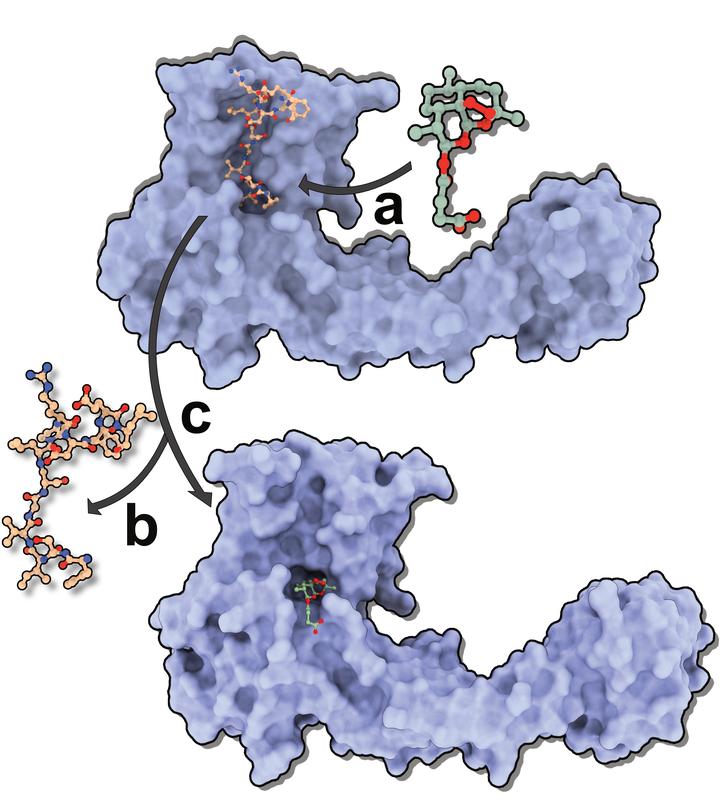New findings about the molecular effectiveness of the anti-malaria drug artemisinin

Schematic representation of the formation of gephyrin-artemisinin complex. Image: Dr. Vikram Kasaragod, Rudolf Virchow Center
Artemisinin is derived from the leaves and flowers of the annual mugwort (Artemisia annua) and has been used in traditional Chinese medicine for centuries. The effectiveness was investigated by the Chinese researcher Tu Youyou and rewarded with the Nobel Prize.
Artemisinin and its semi-synthetic derivatives – collectively known as artemisinins – are used to treat the tropical infectious disease malaria. In addition, these molecules also influence multiple cellular processes in humans.
For example, artemisinins are able to activate the immune system against several types of cancer or to regulate the differentiation of pancreatic T-alpha cells, which could potentially be useful in the therapy of diabetes.
Molecular Mechanisms so far unknown
“Although this clinically-approved drug class is well established and has been used in some extent for centuries, it was unclear which molecular mechanisms underlie the corresponding cellular activities, such as target protein rfhumecognition and modulation,” explains Dr. Vikram Kasaragod.
The postdoctoral fellow in the research group of Prof. Hermann Schindelin at the Rudolf Virchow Center is the first author of this article in the renowned journal “Neuron” and ensures with this research work a significant gain in knowledge (see also the related Preview by Ryan Hibbs in the same Issue of “Neuron”).
Comprehensive model for the regulation of inhibitory neurotransmission developed
The structural biologist was the first to solve the crystal structures of two different artemisinin derivatives – artesunate and artemether – in a complex with gephyrin. By binding to inhibitory glycine and GABAA receptors, gephyrin acts as a central scaffold protein of inhibitory postsynapses in the mammalian central nervous system. Gephyrin has only recently been identified as an artemisinin target protein.
The results clearly demonstrate how artemisinins target the universal receptor binding pocket in gephyrin and compete with the inhibitory neurotransmitter receptors for an overlapping binding site (see picture). These new findings could thus also serve as an effective tool to understand the physiology of the human brain.
According to Kasaragod, the crystal structures form, together with biochemical, electrophysiological and in vivo data, a comprehensive model of the regulation of inhibitory neurotransmission by artemisinine. According to him, this model clearly describes the interactions between proteins and drugs.
Important step for the development of drugs
“Our data not only provide a solid foundation for understanding how artemisinins are recognized by a target molecule, but will also help researchers to develop and optimize these agents into highly specific modulators of gephyrin. These modulators may play an important role in the treatment of neurological diseases such as Alzheimer's disease, schizophrenia and epilepsy,” says Schindelin, the lead investigator.
The data published in Neuron are the result of an interdisciplinary collaboration with other groups at the University of Würzburg, the University Medical Center in Hamburg and the University of Copenhagen.
People
Dr. Vikram Kasaragod postdoctoral fellow in the research group of Prof. Hermann Schindelin at the Rudolf Virchow Center of the University of Würzburg.
Prof. Dr. Hermann Schindelin is Professor of Structural Biology and Biochemistry. Since 2006 he is head of a research group at the Rudolf Virchow Center for Experimental Biomedicine of the University of Würzburg.
Dr. Vikram Kasaragod (Schindelin Group, Rudolf Virchow Center) vikram.kasaragod@virchow.uni-wuerzburg.de
Prof. Dr. Hermann Schindelin (Rudolf Virchow Center)
Tel. 0931 31 80382, hermann.schindelin@virchow.uni-wuerzburg.de
Dr. Daniela Diefenbacher (Press Office, Rudolf Virchow Center)
Tel. 0931 3188631, daniela.diefenbacher@uni-wuerzburg.de
Vikram Babu Kasaragod, Torben Johann Hausrat, Natascha Schaefer, Maximilian Kuhn, Nikolaj Riis Christensen, Ingrid Tessmer, Hans Michael Maric, Kenneth Lindegaard Madsen, Christoph Sotriffer, Carmen Villmann, Matthias Kneussel and Hermann Schindelin: Elucidating the Molecular Basis for Inhibitory Neurotransmission Regulation by Artemisinins. Neuron (2019) https://doi.org/10.1016/j.neurin.2019.01.001
https://www.uni-wuerzburg.de/en/rvz/rvz-news/single/news/new-findings-about-the-…
Media Contact
All latest news from the category: Life Sciences and Chemistry
Articles and reports from the Life Sciences and chemistry area deal with applied and basic research into modern biology, chemistry and human medicine.
Valuable information can be found on a range of life sciences fields including bacteriology, biochemistry, bionics, bioinformatics, biophysics, biotechnology, genetics, geobotany, human biology, marine biology, microbiology, molecular biology, cellular biology, zoology, bioinorganic chemistry, microchemistry and environmental chemistry.
Newest articles

First-of-its-kind study uses remote sensing to monitor plastic debris in rivers and lakes
Remote sensing creates a cost-effective solution to monitoring plastic pollution. A first-of-its-kind study from researchers at the University of Minnesota Twin Cities shows how remote sensing can help monitor and…

Laser-based artificial neuron mimics nerve cell functions at lightning speed
With a processing speed a billion times faster than nature, chip-based laser neuron could help advance AI tasks such as pattern recognition and sequence prediction. Researchers have developed a laser-based…

Optimising the processing of plastic waste
Just one look in the yellow bin reveals a colourful jumble of different types of plastic. However, the purer and more uniform plastic waste is, the easier it is to…



